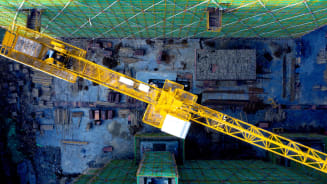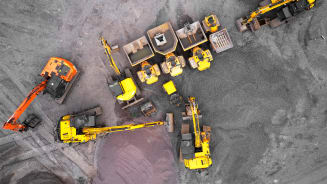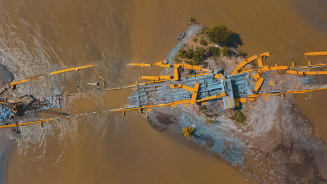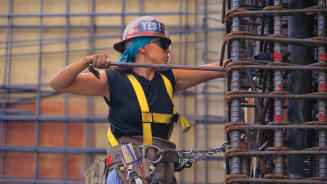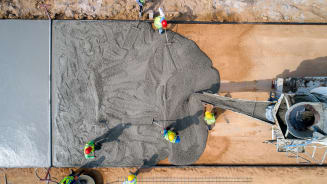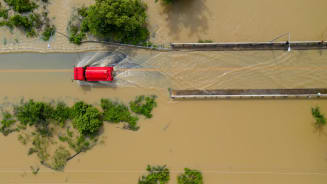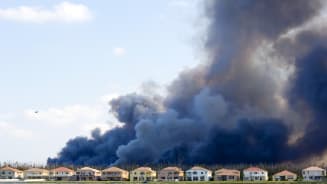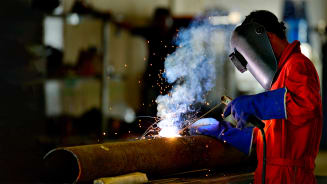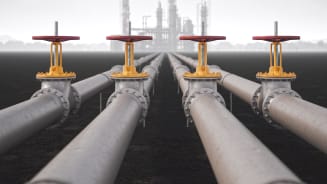Decarbonizing Construction for a Low-Emission Future

Decarbonizing construction demands new materials and approaches, with a focus on managing risk and securing capital. By aligning sustainability with business strategy and risk management, the industry can meet net-zero targets.
Key Takeaways
-
Decarbonizing construction requires innovative materials and technologies, but to achieve scale, companies and insurers must bridge the risk-financing gap.
-
The green transition in construction is associated with complex and converging risks, from supply chain and workforce issues to legal and regulatory considerations.
Across the globe, nearly every sector feels the urgency of decarbonization. As natural catastrophes and their costs mount, the need for systemic change is clear. In construction, where the building value chain is responsible for 37 percent of total carbon emissions globally,1 the scale and depth of change required to meet net-zero targets can feel particularly daunting. And as some regions prepare for significant construction — particularly in the Middle East where demand is surging2 — long-term green solutions are imperative.
Many construction players are looking ahead to get a sense of future risks and opportunities as they explore new materials and technologies, identify new energy sources, manage complex regulations and seek access to capital to fund changes. From retrofitting existing buildings to fundamental changes in materials, such as steel and cement, exploring what’s possible, taking action and managing risk will be critical to the net-zero transition in construction.
Innovating Materials, Technologies and Processes
Greener materials and power sources are an important part of the construction industry’s path to decarbonization, particularly for carbon- and energy-intensive subsectors, including steel and cement. While solutions like green steel hold significant promise, there are clear barriers due to its high cost and need for massive amounts of hydrogen. As questions related to sustainability continue to arise across projects, construction players are starting to think differently and prioritize innovation. They are increasingly focused on resources and energy production, such as how to optimize water consumption at construction sites — using it more efficiently and disposing of contaminated water in cleaner ways — and greener approaches to waste management. As stakeholders seek more sustainable materials, technologies and processes, it’s the construction players that start managing the transition now that will be best positioned for the future.
One challenge in scaling innovative materials and technology is risk financing. Construction projects are already costly, so insurers are understandably cautious about newer technologies, materials and methods — but bridging that gap is key. To help, companies can focus on communicating their overall risk management strategies and the ways sustainable investments support business plans and long-term profitability. Importantly, insurers will also need assurances about the technologies themselves. Use case examples and highlights of a new technology’s proven capabilities, safety and efficacy can expand insurers’ understanding and comfort, helping to shift how they underwrite their risks. In this way, both organizations and insurers can support the scaling of new, greener technology in construction.
Connecting Sustainability, Business Strategy and Risk Management
The transition to a greener construction industry is multi-faceted, requiring companies across the value chain to connect the dots among sustainable investments, business strategy and risk. More investors and institutions are seeking sustainability commitments and energy-efficient approaches, taking a long-term view on returns. Project financing will increasingly require a focus on sustainability and resilience in everything, from planning and materials to energy sources and green spaces. Government subsidies that vary across regions can create global competition and opportunities — pushing construction players to find the right balance in investments and returns across their whole portfolios.
Focusing on data and analytics, including risk quantification and predictive modeling, can strengthen decision making and risk management and help companies attract risk capital. Further, an understanding of the global landscape can help players both secure global sources of risk capital and provide tailored solutions that consider regional risks and nuances.
Managing Decarbonization Risk
The construction sector already faces known risks3 — human capital, supply chain, cyber attacks and property damage, among others. Decarbonization introduces more complex change, but also significant promise. For example, increased demand for sustainable materials, such as low-carbon steel and concrete, will put pressure on construction companies. However, production is likely to increase in the long term — and as production scales, costs will become more manageable. The key for the industry is collaboration.
Collaborating across the construction ecosystem — with both traditional players and more sustainability- and tech-focused entities — and securing more support from insurers, can help organizations collect more data to quantify and mitigate risk. This collaboration can then lead to a shared understanding of innovative materials, technologies and processes, which can aid in accessing risk capital. On the human capital side, construction companies can focus on enhanced employee value propositions, engagement strategies and competitive rewards to attract sustainability talent from other sectors.
Emerging and shifting risks related to decarbonization will also require the right data and counsel. With regulations, tax issues and incentives unfolding at different speeds across the globe, construction players face a good amount of uncertainty. It’s important to understand how regulatory change or tax credits make a project more economically feasible, and the impact of legislation on current projects. Cyber is similarly a growing risk in construction as the industry becomes more digital. And with technology’s role in meeting decarbonization targets and growing demand for certain projects, including data centers and smart buildings, companies need to be even more focused on managing cyber risk and getting the right expertise to do so.
Accessing and Managing Capital for a Net-Zero Future
The good news for the construction industry is that the growing focus on sustainability means companies that get in front of change are likely to find capital available — and following these three steps can further the odds:
- Take a smart, structured approach to decarbonization and sustainability.
- Highlight the ways your company is quantifying and managing risk.
- Focus on proven outcomes that help tell your story. Doing so allows companies to tap available capital.
The process is complex and takes time and effort, particularly for smaller players. But putting capital in the right places can ultimately help the industry as a whole adopt net-zero solutions, create new benchmarks, and scale the adoption and production of new materials, technologies and processes.
The carbon-intensive construction industry is an essential part of daily life, urban development and modernization with an outsize impact on net-zero targets across the globe. While there is much uncertainty, there’s also significant innovation and promise.
Companies can realize that promise and meet the urgent need for decarbonization by using data and analytics to cut through the unknowns and set priorities for risk management and investments, collaborating across the value chain and bridging gaps to access capital.
General Disclaimer
This document is not intended to address any specific situation or to provide legal, regulatory, financial, or other advice. While care has been taken in the production of this document, Aon does not warrant, represent or guarantee the accuracy, adequacy, completeness or fitness for any purpose of the document or any part of it and can accept no liability for any loss incurred in any way by any person who may rely on it. Any recipient shall be responsible for the use to which it puts this document. This document has been compiled using information available to us up to its date of publication and is subject to any qualifications made in the document.
Terms of Use
The contents herein may not be reproduced, reused, reprinted or redistributed without the expressed written consent of Aon, unless otherwise authorized by Aon. To use information contained herein, please write to our team.
Aon's Better Being Podcast
Our Better Being podcast series, hosted by Aon Chief Wellbeing Officer Rachel Fellowes, explores wellbeing strategies and resilience. This season we cover human sustainability, kindness in the workplace, how to measure wellbeing, managing grief and more.
Aon Insights Series Asia
Expert Views on Today's Risk Capital and Human Capital Issues
Aon Insights Series Pacific
Expert Views on Today's Risk Capital and Human Capital Issues
Aon Insights Series UK
Expert Views on Today's Risk Capital and Human Capital Issues
Construction and Infrastructure
The construction industry is under pressure from interconnected risks and notable macroeconomic developments. Learn how your organization can benefit from construction insurance and risk management.
Cyber Labs
Stay in the loop on today's most pressing cyber security matters.
Cyber Resilience
Our Cyber Resilience collection gives you access to Aon’s latest insights on the evolving landscape of cyber threats and risk mitigation measures. Reach out to our experts to discuss how to make the right decisions to strengthen your organization’s cyber resilience.
Employee Wellbeing
Our Employee Wellbeing collection gives you access to the latest insights from Aon's human capital team. You can also reach out to the team at any time for assistance with your employee wellbeing needs.
Environmental, Social and Governance Insights
Explore Aon's latest environmental social and governance (ESG) insights.
Q4 2023 Global Insurance Market Insights
Our Global Insurance Market Insights highlight insurance market trends across pricing, capacity, underwriting, limits, deductibles and coverages.
Regional Results
How do the top risks on business leaders’ minds differ by region and how can these risks be mitigated? Explore the regional results to learn more.
Human Capital Analytics
Our Human Capital Analytics collection gives you access to the latest insights from Aon's human capital team. Contact us to learn how Aon’s analytics capabilities helps organizations make better workforce decisions.
Insights for HR
Explore our hand-picked insights for human resources professionals.
Workforce
Our Workforce Collection provides access to the latest insights from Aon’s Human Capital team on topics ranging from health and benefits, retirement and talent practices. You can reach out to our team at any time to learn how we can help address emerging workforce challenges.
Mergers and Acquisitions
Our Mergers and Acquisitions (M&A) collection gives you access to the latest insights from Aon's thought leaders to help dealmakers make better decisions. Explore our latest insights and reach out to the team at any time for assistance with transaction challenges and opportunities.
Navigating Volatility
How do businesses navigate their way through new forms of volatility and make decisions that protect and grow their organizations?
Parametric Insurance
Our Parametric Insurance Collection provides ways your organization can benefit from this simple, straightforward and fast-paying risk transfer solution. Reach out to learn how we can help you make better decisions to manage your catastrophe exposures and near-term volatility.
Pay Transparency and Equity
Our Pay Transparency and Equity collection gives you access to the latest insights from Aon's human capital team on topics ranging from pay equity to diversity, equity and inclusion. Contact us to learn how we can help your organization address these issues.
Property Risk Management
Forecasters are predicting an extremely active 2024 Atlantic hurricane season. Take measures to build resilience to mitigate risk for hurricane-prone properties.
Technology
Our Technology Collection provides access to the latest insights from Aon's thought leaders on navigating the evolving risks and opportunities of technology. Reach out to the team to learn how we can help you use technology to make better decisions for the future.
Top 10 Global Risks
Trade, technology, weather and workforce stability are the central forces in today’s risk landscape.
Trade
Our Trade Collection gives you access to the latest insights from Aon's thought leaders on navigating the evolving risks and opportunities for international business. Reach out to our team to understand how to make better decisions around macro trends and why they matter to businesses.
Weather
With a changing climate, organizations in all sectors will need to protect their people and physical assets, reduce their carbon footprint, and invest in new solutions to thrive. Our Weather Collection provides you with critical insights to be prepared.
Workforce Resilience
Our Workforce Resilience collection gives you access to the latest insights from Aon's Human Capital team. You can reach out to the team at any time for questions about how we can assess gaps and help build a more resilience workforce.
More Like This
-

Article 15 mins
Navigating Cyber Risks in EMEA: Key Insights for 2025
Organizations in EMEA face unprecedented challenges as cyber threats become more sophisticated. In the face of emerging AI, evolving regulations and geopolitical tensions, businesses should strengthen their resilience to better navigate the complexities of the digital age.
-

Article 6 mins
Outsourced Chief Investment Officer: The Key to Navigating Volatility
In a volatile climate, institutional investors are turning to outsourced chief investment officers to conquer administrative, regulatory and market challenges.
-

Article 8 mins
The CFO Roadmap: Expanding Success Beyond Financial Metrics
In today's intricate business environment, growth is expanding to include more than financial success. By understanding how to fund, shape and secure growth, organizations can build resilience and drive long-term value.






















